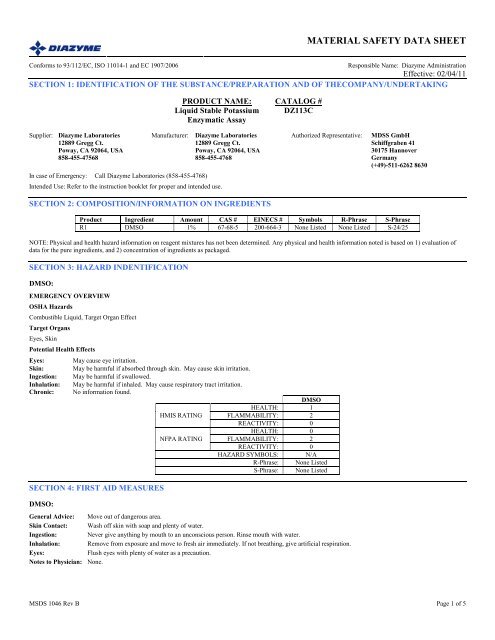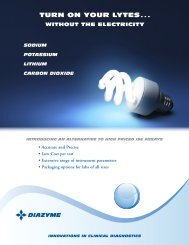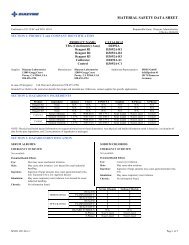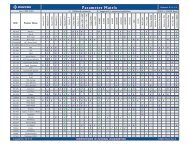MSDS - Diazyme Laboratories
MSDS - Diazyme Laboratories
MSDS - Diazyme Laboratories
Create successful ePaper yourself
Turn your PDF publications into a flip-book with our unique Google optimized e-Paper software.
MATERIAL SAFETY DATA SHEET<br />
Conforms to 93/112/EC, ISO 11014-1 and EC 1907/2006<br />
Responsible Name: <strong>Diazyme</strong> Administration<br />
Effective: 02/04/11<br />
SECTION 1: IDENTIFICATION OF THE SUBSTANCE/PREPARATION AND OF THECOMPANY/UNDERTAKING<br />
Supplier: <strong>Diazyme</strong> <strong>Laboratories</strong><br />
12889 Gregg Ct.<br />
Poway, CA 92064, USA<br />
858-455-47568<br />
Manufacturer:<br />
PRODUCT NAME:<br />
Liquid Stable Potassium<br />
Enzymatic Assay<br />
In case of Emergency: Call <strong>Diazyme</strong> <strong>Laboratories</strong> (858-455-4768)<br />
Intended Use: Refer to the instruction booklet for proper and intended use.<br />
<strong>Diazyme</strong> <strong>Laboratories</strong><br />
12889 Gregg Ct.<br />
Poway, CA 92064, USA<br />
858-455-4768<br />
SECTION 2: COMPOSITION/INFORMATION ON INGREDIENTS<br />
CATALOG #<br />
DZ113C<br />
Authorized Representative:<br />
MDSS GmbH<br />
Schiffgraben 41<br />
30175 Hannover<br />
Germany<br />
(+49)-511-6262 8630<br />
Product Ingredient Amount CAS # EINECS # Symbols R-Phrase S-Phrase<br />
R1 DMSO 1% 67-68-5 200-664-3 None Listed None Listed S-24/25<br />
NOTE: Physical and health hazard information on reagent mixtures has not been determined. Any physical and health information noted is based on 1) evaluation of<br />
data for the pure ingredients, and 2) concentration of ingredients as packaged.<br />
SECTION 3: HAZARD INDENTIFICATION<br />
DMSO:<br />
EMERGENCY OVERVIEW<br />
OSHA Hazards<br />
Combustible Liquid, Target Organ Effect<br />
Target Organs<br />
Eyes, Skin<br />
Potential Health Effects<br />
Eyes: May cause eye irritation.<br />
Skin: May be harmful if absorbed through skin. May cause skin irritation.<br />
Ingestion: May be harmful if swallowed.<br />
Inhalation: May be harmful if inhaled. May cause respiratory tract irritation.<br />
Chronic: No information found.<br />
DMSO<br />
HEALTH: 1<br />
HMIS RATING FLAMMABILITY: 2<br />
REACTIVITY: 0<br />
HEALTH: 0<br />
NFPA RATING FLAMMABILITY: 2<br />
REACTIVITY: 0<br />
HAZARD SYMBOLS: N/A<br />
R-Phrase: None Listed<br />
S-Phrase: None Listed<br />
SECTION 4: FIRST AID MEASURES<br />
DMSO:<br />
General Advice: Move out of dangerous area.<br />
Skin Contact: Wash off skin with soap and plenty of water.<br />
Ingestion: Never give anything by mouth to an unconscious person. Rinse mouth with water.<br />
Inhalation: Remove from exposure and move to fresh air immediately. If not breathing, give artificial respiration.<br />
Eyes:<br />
Flush eyes with plenty of water as a precaution.<br />
Notes to Physician: None.<br />
<strong>MSDS</strong> 1046 Rev B Page 1 of 5
MATERIAL SAFETY DATA SHEET<br />
Conforms to 93/112/EC, ISO 11014-1 and EC 1907/2006<br />
SECTION 5: FIRE FIGHTING MEASURES<br />
Responsible Name: <strong>Diazyme</strong> Administration<br />
Effective: 02/04/11<br />
DMSO:<br />
Flammable Properties:<br />
PPE for Firefighters:<br />
Extinguishing Media:<br />
Flash Point: 87 °C (189 °F) – closed cup.<br />
Ignition Temperature: 301 °C (574 °F)<br />
As in any fire, wear a self-contained breathing apparatus in pressure-demand, MSHA/NIOSH (approved or equivalent), and full protective<br />
gear if necessary.<br />
Use water spray, alcohol-resistant foam, dry chemical, or carbon dioxide.<br />
SECTION 6: ACCIDENTAL RELEASE MEASURES<br />
DMSO:<br />
Personal Precautions: Avoid breathing vapors, mist or gas.<br />
Environmental Precautions: Do not let product enter drains.<br />
Spills/Leaks:<br />
Keep in suitable, closed disposal containers for disposal.<br />
SECTION 7: HANDLING AND STORAGE<br />
DMSO:<br />
Handling:<br />
Storage:<br />
Keep away from sources of ignition – No smoking. Take measures to prevent the buildup of electrostatic charge.<br />
Store in a tightly closed container. Store in a cool, dry, well-ventilated area away from incompatible substances. Store under inert gas. Hygroscopic.<br />
SECTION 8: EXPOSURE CONTROLS / PERSONAL PROTECTION<br />
DMSO:<br />
Exposure Limits<br />
Contains no substances with occupational exposure limit values.<br />
Personal Protective Equipment<br />
Respirators: Respiratory protection is not required. Where protection is desired, use multi-purpose combination (US) or type ABEK (EN 14387) respirator cartridges.<br />
Use respirators and components tested and approved under appropriate government standards such as NIOSH (US) or CEN (EU).<br />
Eyes: Wear chemical safety goggles/glasses.<br />
Skin: Wear appropriate protective gloves to prevent skin exposure.<br />
Clothing: Wear appropriate protective clothing to minimize contact with skin.<br />
Hygiene measures: General industrial hygiene practice.<br />
SECTION 9: PHYSICAL AND CHEMICAL PROPERTIES<br />
DMSO:<br />
Physical State:<br />
Liquid<br />
Color:<br />
Colorless<br />
pH:<br />
Not available<br />
Vapor Pressure:<br />
0.55 hPa (0.41 mm Hg) @ 20 deg C (68 °F)<br />
Boiling Point:<br />
189 deg C (372 °F) at 1,013 hPa (760 mmHg)<br />
Freezing/Melting Point: 18.4 deg C (65.1 C<br />
Autoignition Temperature: 301 deg C (574 °F)<br />
Flash Point:<br />
87 deg C (198 °F) – closed cup<br />
Explosion Limits: Lower: 3.5 vol %<br />
Explosion Limits: Upper: 42 vol %<br />
Solubility in water:<br />
Completely miscible<br />
Specific Gravity/Density: 1.1 g/cm 3<br />
Molecular Formula: C 2H 6 OS<br />
Molecular Weight:<br />
78.13 g/mol<br />
Partition coefficient: log Pow: -2.03<br />
Relative Vapor Density: 2.70 – (Air = 1.0)<br />
<strong>MSDS</strong> 1046 Rev B Page 2 of 5
MATERIAL SAFETY DATA SHEET<br />
Conforms to 93/112/EC, ISO 11014-1 and EC 1907/2006<br />
SECTION 10: STABILITY AND REACTIVITY<br />
Responsible Name: <strong>Diazyme</strong> Administration<br />
Effective: 02/04/11<br />
DMSO:<br />
Chemical Stability:<br />
Incompatibilities with Other Materials:<br />
Hazardous Decomposition Products:<br />
Hazardous Polymerization:<br />
Stable under recommended storage conditions. Hygroscopic: absorbs moisture or water from the air.<br />
Acid chlorides, Phosphorus halides, Strong acids, Strong oxidizing agents, Strong reducing agents.<br />
Hazardous decomposition products formed under fire conditions. – Carbon oxides, Sulfur oxides.<br />
Will not occur.<br />
SECTION 11: TOXICOLOGICAL INFORMATION<br />
DMSO:<br />
Acute toxicity:<br />
LD50 Oral – rat – 14,500 mg/kg<br />
LD50 Inhalation – rat – 4 hr. - 40250 ppm<br />
LD50 Dermal – rabbit – > 5,000 mg/kg<br />
Irritation and Corrosion: Skin – rabbit – mild skin irritation – 24 hr.<br />
Eyes – rabbit – mild eye irritation<br />
Sensitization: No data available.<br />
Chronic Exposure:<br />
Carcinogenicity – rat – Oral<br />
Tumorigenic : Equivocal tumorigenic agent by RTECS criteria. Skin and Appendages: Other: Tumors.<br />
Carcinogenicity – mouse – Oral<br />
Tumorigenic : Equivocal tumorigenic agent by RTECS criteria. Leukaemia Skin and Appendages: Other: Tumors.<br />
IARC:<br />
ACGIH:<br />
NTP:<br />
OSHA:<br />
No component of this product present at levels greater than or equal to 0.1% is identified as probable, possible or confirmed human carcinogen by<br />
IARC.<br />
No component of this product present at levels greater than or equal to 0.1% is identified as a carcinogen or potential carcinogen by ACGIH.<br />
No component of this product present at levels greater than or equal to 0.1% is identified as a known or anticipated carcinogen by ACGIH.<br />
No component of this product present at levels greater than or equal to 0.1% is identified as a carcinogen or potential carcinogen by OSHA.<br />
Genotoxicity in vitro – mouse – lymphocyte<br />
Cytogenetic analysis<br />
Genotoxicity in vitro – mouse – lymphocyte<br />
Mutation in mammalian somatic cells<br />
Genotoxicity in vivo – rat – Intraperitoneal<br />
Cytogenetic analysis<br />
Genotoxicity in vivo – mouse – Intraperitoneal<br />
DNA damage<br />
Developmental toxicity – mouse – Intraperitoneal<br />
Effects on Embryo or Fetus: Fetotxicity (except death, e.g., stunted fetus). Specific Developmental Abnomalities: Musculoskeletal system.<br />
Reproductive toxicity – rat – Intraperitoneal<br />
Effects on Fertility: Abortion.<br />
Reproductive toxicity – rat – Intraperitoneal<br />
Effects on Fertility: Post-implantation mortality (e.g., dead and/or resorbed implants per total number of implants).<br />
Reproductive toxicity – rat – Subcutaneous<br />
Effects on Fertility: Post-implantation mortality (e.g., dead and/or resorbed implants per total number of implants).<br />
Effects on Fertility: Litter Size (e.g., number of fetuses per litter; measured before birth).<br />
Reproductive toxicity – mouse – Oral<br />
Effects on Fertility: Post-implantation mortality (e.g., reduction in number of implants per female; total number of implants per corpora lutea).<br />
Effects on Embryo or Fetus: Fetotxicity (except death, e.g., stunted fetus). Specific Developmental Abnormalities: Musculoskeletal system.<br />
Potential Health Effects<br />
Eye:<br />
May cause eye irritation.<br />
Skin:<br />
May be harmful if absorbed through skin. May cause skin irritation.<br />
Ingestion: May be harmful if swallowed.<br />
Inhalation: May be harmful if inhaled. May cause respiratory tract irritation.<br />
Target Organs: Eyes, Skin.<br />
Additional Information:<br />
RTECS: PV6210000<br />
<strong>MSDS</strong> 1046 Rev B Page 3 of 5
MATERIAL SAFETY DATA SHEET<br />
Conforms to 93/112/EC, ISO 11014-1 and EC 1907/2006<br />
SECTION 12: ECOLOGICAL INFORMATION<br />
Responsible Name: <strong>Diazyme</strong> Administration<br />
Effective: 02/04/11<br />
DMSO:<br />
Elimination Information (persistence and degradability:<br />
No data available<br />
Ecotoxicity Effects: Fish: Pimephales promelas (fathead minnow): LC50 = 34,000 mg/L; 96 Hr<br />
Fish: Oncorhynchus mykiss (rainbow trout): LC50 = 35,000 mg/L; 96 Hr<br />
Water flea Daphnia: Daphnia pulex (Water flea) EC50 = 27,500 mg/L<br />
Algae: Lepomis macrochirus (Bluegill) EC50 > 400,000 mg/L; 96 Hr<br />
Further information on ecology:<br />
No data available<br />
SECTION 13: DISPOSAL CONSIDERATIONS<br />
DMSO:<br />
Product: Contact a licensed professional waste disposal service to dispose this material. This combustible material may be burned in a chemical incinerator equipped<br />
with an afterburner and scrubber. Observe all federal state and local environmental regulations.<br />
Contaminated Packaging: Dispose of as unused product.<br />
SECTION 14: TRANSPORTATION INFORMATION<br />
DMSO:<br />
IATA IMDG RID/ADR DOT (US)<br />
Shipping Name: Not regulated. Not regulated. Not regulated. Combustible liquid, n.o.s. (Dimethyl Sulfoxide)<br />
Hazard Class:<br />
UN Number:<br />
Packing Group:<br />
SECTION 15: REGULATORY INFORMATION<br />
DMSO:<br />
OSHA Hazards<br />
Combustible Liquid, Target Organ Effect<br />
III<br />
UN-Number: 1993, Class: CBL<br />
Marine Pollutant: No, Poison Inhalation Hazard: No.<br />
SARA 302 Components<br />
SARA 302: No chemicals in this material are subject to the reporting requirements of SARA Title III, Section 302<br />
SARA 313 Components<br />
SARA 302: This material does not contain any chemical components with known CAS numbers that exceed the threshold (De Minimis) reporting levels established<br />
by SARA Title III, Section 313<br />
SARA 1/312 Hazards<br />
Fire hazard, Chronic Health Hazard<br />
European/International Regulations<br />
European Labeling in Accordance with EC Directives<br />
Hazard Symbols: Combustible<br />
Risk Phrases:<br />
Safety Phrases:<br />
S-24/25: Avoid contact with skin and eyes.<br />
WGK (Water Danger/Protection)<br />
CAS# 67-68-5: 0<br />
Canada<br />
CAS# 67-68-5 is listed on Canada's DSL List<br />
US Federal<br />
TSCA<br />
CAS# 67-68-5 is listed on the TSCA Inventory.<br />
<strong>MSDS</strong> 1046 Rev B Page 4 of 5
MATERIAL SAFETY DATA SHEET<br />
Conforms to 93/112/EC, ISO 11014-1 and EC 1907/2006<br />
SECTION 16: OTHER INFORMATION<br />
Responsible Name: <strong>Diazyme</strong> Administration<br />
Effective: 02/04/11<br />
PREPARED BY: <strong>Diazyme</strong> Administration<br />
PHONE NO: 858-455-4768<br />
DATE PREPARED: 2011-01-28<br />
The information provided on this Material Safety Data Sheet is provided in the interest of promoting safe handling of the material. While this information is believed to<br />
be correct <strong>Diazyme</strong> makes no warranty in respect to any of the information disclosed. Observe all federal, provincial, state and local laws concerning health and pollution.<br />
<strong>MSDS</strong> 1046 Rev B Page 5 of 5








